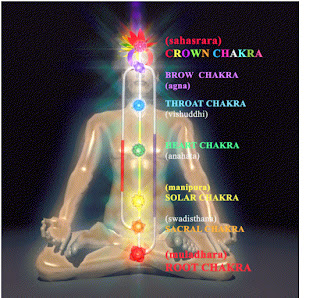Dear Friends,
Namaste!
This is the 50th article in our series. We have reached so far only because of God’s infinite grace and we hope He will very benignly enable us to complete the entire journey (of 1111 articles) we have undertaken.
Last week we were discussing “Pingala” and “Ida” – the channels (“Nadi”) through which life-force (“Prana”) flows when we breathe. These channels are intertwined with each other and run from the top of our head all the way down to the base of our spine. On the way, they cross each other at seven places. These junctions (or nerve centres) are known in Yogic terminology as “Chakra” (wheels). The seven Chakras are as follows:
1. “Muladhara” (root-support) – This Chakra is at the base of the spine just above the anus and coincides with the sacral plexus.
2. “Swadhishthana” (place of our origin) – This Chakra is situated just above the genitals and coincides with the lumbar or hypogastric plexus.
3. “Manipura” (jewel’s place) – This Chakra is located at the navel and coincides with the solar plexus.
4. “Anahat” (constantly-resounding) – This Chakra is situated at the heart and coincides with the cardiac and pulmonary plexus.
5. “Vishuddha” (supremely pure) – This Chakra is located at the throat and corresponds to the brachial or pharyngeal plexus.
6. “Ajna” (eye of inner awareness) – This Chakra is located at the centre of the eyebrows and corresponds to the choroid plexus.
7. “Sahasrara” (a thousand petals) – This Chakra is situated at the crown of the head and
aligns with the upper cerebral centre.
aligns with the upper cerebral centre.
Life-force descends through Ida and Pingala and rises up through a third Nadi called “Sushumna” ascending straight up the spine.
In Yoga, it is believed that “Kundalini” (the serpent power symbolic of our consciousness) is seated at the base of our spine. It is coiled and “sleeping” or “slumbering”. Yogic practices (the practice of eight limbs coupled with main Yoga types), “wake-up” the serpent power upon which it rises through the spine (“Sushumna Nadi”) through various Chakras all the way up to the topmost Chakra. In other words, our consciousness gets purified from a totally materialistic view of “self” (because the Muladhara Chakra represents the Earth element which also is the most gross of all elements) to super-consciousness where we experience our “self” totally united with the supreme cosmic energy (“Brahman”) of which this entire Universe is but a mere manifestation!
But let’s come back to how “Buddhasana” helps control of life-force through Pingala and Ida!
When life-force flows through “Pingala” representative of the Solar or Contracting force, it creates, builds, generates. When it flows through “Ida”, it cools, mends, rests.
Life-force flows through “Pingala” when we breathe through the right nostril. And it flows through “Ida” when we breathe through the left nostril. We can control the nostril we breathe through “Buddhasana”. If we sleep on our left side, “Pingala” is opened up and our breath starts flowing through our right nostril. Alternatively, when we sleep on our right side, “Ida” is opened up and our breath starts flowing through our left nostril. (It is for this very reason that Buddhasana is useful when our nose gets choked while suffering from cold! If the left or right or both nostrils are blocked, we should do Buddhasana for clearing the way of our breath. Instead, we try to force the breath by breathing hard which only increases the blood flow in the area and further swells up the walls of the nostrils and restricts flow of air!!)
So, by alternating between the left and the right sides in Buddhasana, we can actually control the resting and re-building of our body.
Yoga also specifies a guideline about how much and in what sequence we should practise Buddhasana when sleeping. The first time we assume this posture, we should sleep on our left side and take eight full breaths consisting of inhale and exhale. Then we should turn on our right side and take sixteen full breaths. Then we should again turn on our left side and take thirty two full breaths. Beyond this, we can go into Shavasana or Makarasana or continue in Buddhasana and alternate among the three asanas as we like. In fact, once we fall asleep, the body automatically shuffles among the three depending upon whether it is cooling or heating up to maintain equilibrium in our system and complete the process of sleeping (resting and recuperating)!
The discussion on the subject of sleeping can never be complete without alluding to dreams! Yoga has given a very scientific and logical treatment to this topic. In fact we have earlier seen that “Dreaming” has been treated as one of the five valid states in which we spend our entire life!
Let’s now see how Yoga puts dreams in perspective.
Dream on...

No comments:
Post a Comment